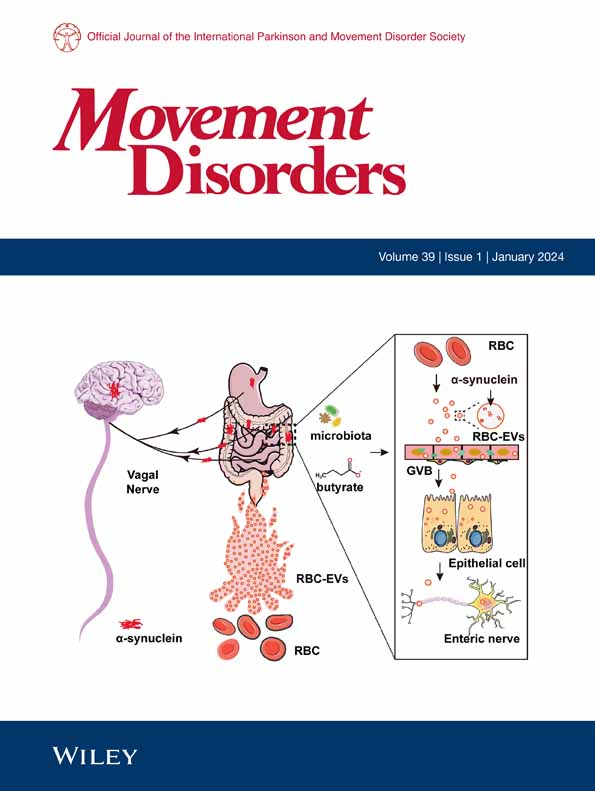求助PDF
{"title":"快速眼动睡眠行为障碍--雷伊氏体病持续状态中β-淀粉样蛋白负荷对认知的影响。","authors":"Kyung Ah Woo,Eun Jin Yoon,Seoyeon Kim,Heejung Kim,Ryul Kim,Bora Jin,Seungmin Lee,Hyunwoong Park,Hyunwoo Nam,Yu Kyeong Kim,Jee-Young Lee","doi":"10.1002/mds.30031","DOIUrl":null,"url":null,"abstract":"BACKGROUND\r\nRapid eye movement sleep behavior disorder (RBD) is linked to the diffuse-malignant subtype and higher cognitive burden in Lewy body disease (LBD).\r\n\r\nOBJECTIVE\r\nThis study explores brain β-amyloid deposition and its association with cognitive decline across the RBD-LBD continuum.\r\n\r\nMETHODS\r\nPatients with isolated RBD (iRBD), Parkinson's disease with probable RBD (PDRBD), and dementia with Lewy bodies with probable RBD (DLBRBD) underwent 18F-florbetaben positron emission tomography, 3T magnetic resonance imaging scans, and comprehensive neuropsychological assessments. Subjects were categorized as cognitively normal (NC), mild cognitive impairment (MCI), or dementia. Global and regional standardized uptake value ratios (SUVR) were estimated in predefined cognitive volumes of interest (VOI) derived from voxel-wise comparison analysis among the cognitive groups, namely the prefrontal, parietal, precentral cortices, lingual gyrus, and supplementary motor area. Generalized linear models assessed the relationship between 18F-florbetaben SUVRs and neuropsychological testing, adjusting for age and sex. Subgroup analysis focused on the polysomnography-confirmed iRBD-continuum subset (n = 41) encompassing phenoconverters and nonconverters in our prospective iRBD cohort.\r\n\r\nRESULTS\r\nEighty-six subjects were classified as follows: 14 NC, 54 MCI, and 18 dementia. The proportion of positive β-amyloid scans increased with advanced cognitive stages (P = 0.038). β-Amyloid signals in cognitive VOIs were elevated in subgroups showing impairment in Trail-Making Test B (TMT-B). A linear association between TMT-B z score and global cortical β-amyloid levels was observed in the iRBD-continuum subset (P = 0.013).\r\n\r\nCONCLUSION\r\nCortical β-amyloid accumulates with declines in executive function within the RBD-LBD continuum. TMT-B performance may be a useful marker associating with β-amyloid load, particularly in the iRBD population. © 2024 The Author(s). Movement Disorders published by Wiley Periodicals LLC on behalf of International Parkinson and Movement Disorder Society.","PeriodicalId":213,"journal":{"name":"Movement Disorders","volume":"11 1","pages":""},"PeriodicalIF":7.4000,"publicationDate":"2024-10-14","publicationTypes":"Journal Article","fieldsOfStudy":null,"isOpenAccess":false,"openAccessPdf":"","citationCount":"0","resultStr":"{\"title\":\"Cognitive Impact of β-Amyloid Load in the Rapid Eye Movement Sleep Behavior Disorder-Lewy Body Disease Continuum.\",\"authors\":\"Kyung Ah Woo,Eun Jin Yoon,Seoyeon Kim,Heejung Kim,Ryul Kim,Bora Jin,Seungmin Lee,Hyunwoong Park,Hyunwoo Nam,Yu Kyeong Kim,Jee-Young Lee\",\"doi\":\"10.1002/mds.30031\",\"DOIUrl\":null,\"url\":null,\"abstract\":\"BACKGROUND\\r\\nRapid eye movement sleep behavior disorder (RBD) is linked to the diffuse-malignant subtype and higher cognitive burden in Lewy body disease (LBD).\\r\\n\\r\\nOBJECTIVE\\r\\nThis study explores brain β-amyloid deposition and its association with cognitive decline across the RBD-LBD continuum.\\r\\n\\r\\nMETHODS\\r\\nPatients with isolated RBD (iRBD), Parkinson's disease with probable RBD (PDRBD), and dementia with Lewy bodies with probable RBD (DLBRBD) underwent 18F-florbetaben positron emission tomography, 3T magnetic resonance imaging scans, and comprehensive neuropsychological assessments. Subjects were categorized as cognitively normal (NC), mild cognitive impairment (MCI), or dementia. Global and regional standardized uptake value ratios (SUVR) were estimated in predefined cognitive volumes of interest (VOI) derived from voxel-wise comparison analysis among the cognitive groups, namely the prefrontal, parietal, precentral cortices, lingual gyrus, and supplementary motor area. Generalized linear models assessed the relationship between 18F-florbetaben SUVRs and neuropsychological testing, adjusting for age and sex. Subgroup analysis focused on the polysomnography-confirmed iRBD-continuum subset (n = 41) encompassing phenoconverters and nonconverters in our prospective iRBD cohort.\\r\\n\\r\\nRESULTS\\r\\nEighty-six subjects were classified as follows: 14 NC, 54 MCI, and 18 dementia. The proportion of positive β-amyloid scans increased with advanced cognitive stages (P = 0.038). β-Amyloid signals in cognitive VOIs were elevated in subgroups showing impairment in Trail-Making Test B (TMT-B). A linear association between TMT-B z score and global cortical β-amyloid levels was observed in the iRBD-continuum subset (P = 0.013).\\r\\n\\r\\nCONCLUSION\\r\\nCortical β-amyloid accumulates with declines in executive function within the RBD-LBD continuum. TMT-B performance may be a useful marker associating with β-amyloid load, particularly in the iRBD population. © 2024 The Author(s). Movement Disorders published by Wiley Periodicals LLC on behalf of International Parkinson and Movement Disorder Society.\",\"PeriodicalId\":213,\"journal\":{\"name\":\"Movement Disorders\",\"volume\":\"11 1\",\"pages\":\"\"},\"PeriodicalIF\":7.4000,\"publicationDate\":\"2024-10-14\",\"publicationTypes\":\"Journal Article\",\"fieldsOfStudy\":null,\"isOpenAccess\":false,\"openAccessPdf\":\"\",\"citationCount\":\"0\",\"resultStr\":null,\"platform\":\"Semanticscholar\",\"paperid\":null,\"PeriodicalName\":\"Movement Disorders\",\"FirstCategoryId\":\"3\",\"ListUrlMain\":\"https://doi.org/10.1002/mds.30031\",\"RegionNum\":1,\"RegionCategory\":\"医学\",\"ArticlePicture\":[],\"TitleCN\":null,\"AbstractTextCN\":null,\"PMCID\":null,\"EPubDate\":\"\",\"PubModel\":\"\",\"JCR\":\"Q1\",\"JCRName\":\"CLINICAL NEUROLOGY\",\"Score\":null,\"Total\":0}","platform":"Semanticscholar","paperid":null,"PeriodicalName":"Movement Disorders","FirstCategoryId":"3","ListUrlMain":"https://doi.org/10.1002/mds.30031","RegionNum":1,"RegionCategory":"医学","ArticlePicture":[],"TitleCN":null,"AbstractTextCN":null,"PMCID":null,"EPubDate":"","PubModel":"","JCR":"Q1","JCRName":"CLINICAL NEUROLOGY","Score":null,"Total":0}
引用次数: 0
引用
批量引用
Cognitive Impact of β-Amyloid Load in the Rapid Eye Movement Sleep Behavior Disorder-Lewy Body Disease Continuum.
BACKGROUND
Rapid eye movement sleep behavior disorder (RBD) is linked to the diffuse-malignant subtype and higher cognitive burden in Lewy body disease (LBD).
OBJECTIVE
This study explores brain β-amyloid deposition and its association with cognitive decline across the RBD-LBD continuum.
METHODS
Patients with isolated RBD (iRBD), Parkinson's disease with probable RBD (PDRBD), and dementia with Lewy bodies with probable RBD (DLBRBD) underwent 18F-florbetaben positron emission tomography, 3T magnetic resonance imaging scans, and comprehensive neuropsychological assessments. Subjects were categorized as cognitively normal (NC), mild cognitive impairment (MCI), or dementia. Global and regional standardized uptake value ratios (SUVR) were estimated in predefined cognitive volumes of interest (VOI) derived from voxel-wise comparison analysis among the cognitive groups, namely the prefrontal, parietal, precentral cortices, lingual gyrus, and supplementary motor area. Generalized linear models assessed the relationship between 18F-florbetaben SUVRs and neuropsychological testing, adjusting for age and sex. Subgroup analysis focused on the polysomnography-confirmed iRBD-continuum subset (n = 41) encompassing phenoconverters and nonconverters in our prospective iRBD cohort.
RESULTS
Eighty-six subjects were classified as follows: 14 NC, 54 MCI, and 18 dementia. The proportion of positive β-amyloid scans increased with advanced cognitive stages (P = 0.038). β-Amyloid signals in cognitive VOIs were elevated in subgroups showing impairment in Trail-Making Test B (TMT-B). A linear association between TMT-B z score and global cortical β-amyloid levels was observed in the iRBD-continuum subset (P = 0.013).
CONCLUSION
Cortical β-amyloid accumulates with declines in executive function within the RBD-LBD continuum. TMT-B performance may be a useful marker associating with β-amyloid load, particularly in the iRBD population. © 2024 The Author(s). Movement Disorders published by Wiley Periodicals LLC on behalf of International Parkinson and Movement Disorder Society.


